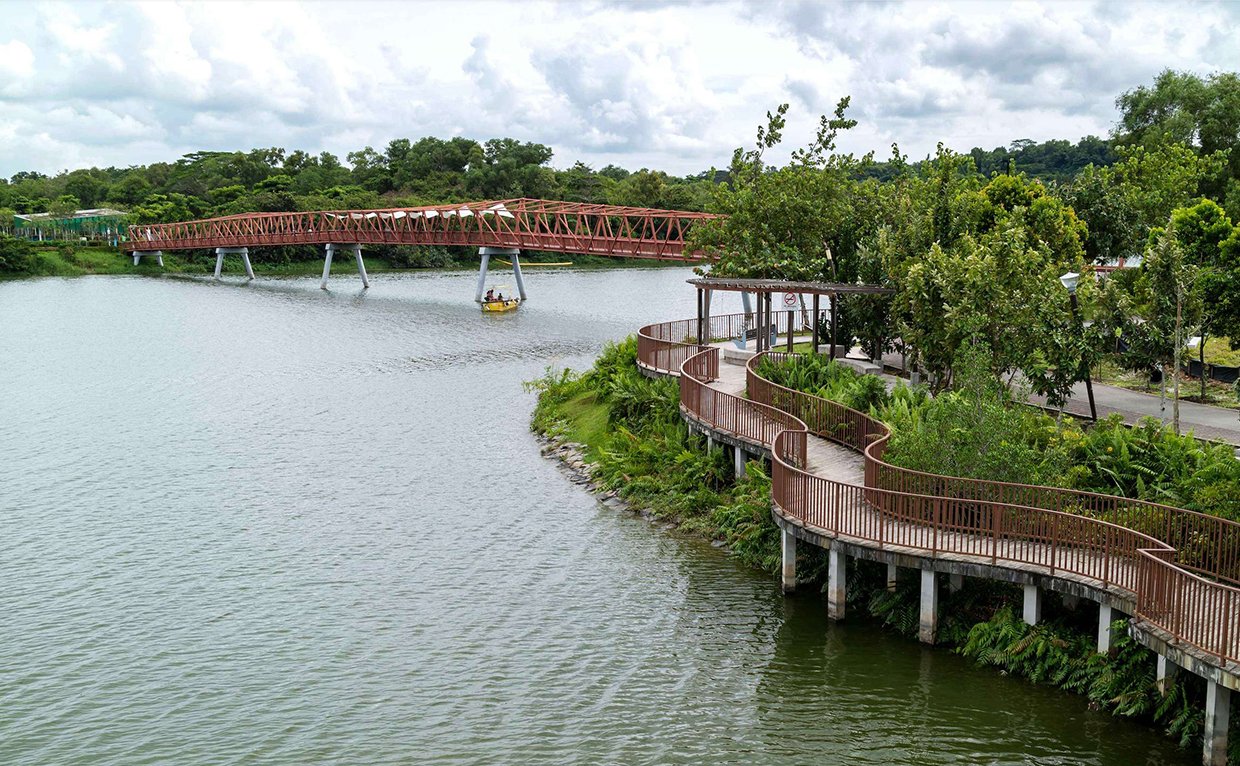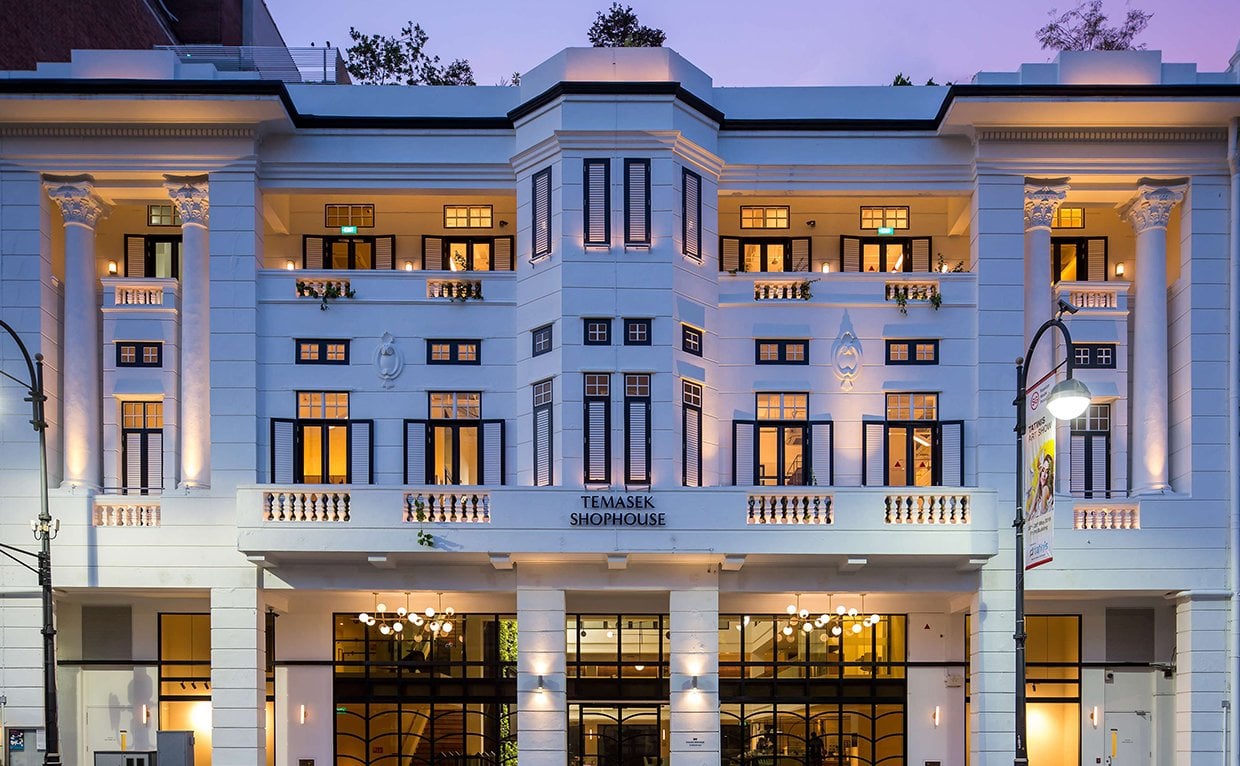Menu
THE DESIGN LEGACY OF PUNGGOL WATERWAY
Recycling materials with landscape design to boost
sustainability and biodiversity
Landscape Architect
SJ Architecture
January 2022
Lush vegetation and active community spaces drape the edges
of the waterway
Abstract: At 4.2km, Punggol Waterway is the longest man-made waterway in Singapore. An
award-winning architecture and engineering masterpiece by Surbana Jurong, it is a popular
recreational spot in the northeast of Singapore. As one of Singapore’s first ABC (Active, Beautiful and
Clean) Waters project at a large scale, it has shown how environmental and social sustainability work
together in the creation of a natural environment with interactive communal spaces and water-based
recreational activities from bare land. Ten years on, its innovative design and engineering are inspiring
similar concepts in new public housing estates in Singapore.
Popular landmark in Singapore
Punggol Waterway is Singapore’s longest man-made waterway. It is one of the most recognisable
landmarks in the country, known for its rustic charm and biodiversity. As a bustling waterfront hub
completed 10 years ago, it is a success story of how the re-introduction of nature and heritage has
resulted in the achievement of both environmental and social sustainability.
In this article, we revisit the project to see that impact it has had vis-à-vis the intent that it was designed
for. Its resounding success is echoed in this quote by Leo Tolstoy: “One of the first conditions of
happiness is that the link between man and nature shall not be broken.”
Located in the vicinity of the Punggol Jetty, Punggol was believed to have existed before Sir Stamford
Raffles founded Singapore in 1819. Punggol Point or Tanjong Punggol appears on Franklin and
Jackson’s 1828 map of Singapore. The place is said to take its name from the river Sungei Ponggol,
with the word “Ponggol” referring to “tree stump” or “hurling sticks”.
Punggol now directly borders Sengkang to the south and shares riverine boundaries with the planning
area of Seletar to the west and Pasir Ris to the east.
The Vision
The project brief envisioned the waterways as a “living organism” of Punggol. There would be a green
promenade for a sustainable life-scape and to achieve the waterfront living objectives of ABC (Active,
Beautiful and Clean) Waters of bringing people closer to water, while providing communal spaces
offering water-based recreational activities.
The blueprint for “Punggol 21” was first unveiled in 1996 by Singapore’s former Prime Minister, Mr Goh
Chok Tong. It had the vision of developing Punggol into A Waterfront Town of the 21st Century. A key
strategy was the mammoth undertaking to dam up the two rivers: Sungei Serangoon and Sungei
Punggol flanking Punggol Town and introduce a man-made waterway running through the town to
connect these two water bodies, giving birth to the idea of Punggol Waterway. A design competition was
launched in May 2008, in which SJ’s design emerged as the winner. On 23 October 2011, Prime
Minister Lee Hsien Loong officially unveiled the “My Waterway@Punggol”.
The project has been a pioneering project in many ways and came with its fair share of challenges.
As a joint agency project between the Housing & Development Board (HDB) and National Parks Board
(NParks), the design process was a collaboration between the authorities and consultants of Surbana
Jurong. The team adopted an interactive design process. As one of Singapore’s first ABC (Active,
Beautiful and Clean) Waters project at an unprecedented scale, the objective of creating a natural
environment – with interactive communal spaces and water-based recreational activities – from scratch
was a challenge; both in design and construction terms. For instance, the soil was poor, and the site
lacked existing vegetation. In addition, the consultant team also needed to integrate sustainable lush
green landscapes, reintroduce biodiversity and an effective system of flood mitigation and hydrology.
The design process was a collaboration between the authorities and consultants of Surbana Jurong where the team adopted an interactive design process.
Concept:
Integrating
Green, Blue
and
Community
The concept revolved around integrating three key
elements. The first was the green element – the
intent was to intensify greenery to help mitigate the
urban heat effect on Punggol town. The second
was blue, with the adoption of water management
initiatives to improve the quality of water. The third
was the element of community: the application of
universal design principles to create seamless
connectivity across interactive water-based
activities. The concept thus enabled the seamless
integration of environmentally sustainable features
and storm-water management practices together
with the creation of a variety of community spaces.
The 4.2-km long waterway is oriented in an
East-West direction. It features a landscaped
promenade with two tributaries. Four vehicular
bridges and five footbridges allow for seamless
vehicular and pedestrians access. Built at a cost of
S$225 million, it took three years to complete.
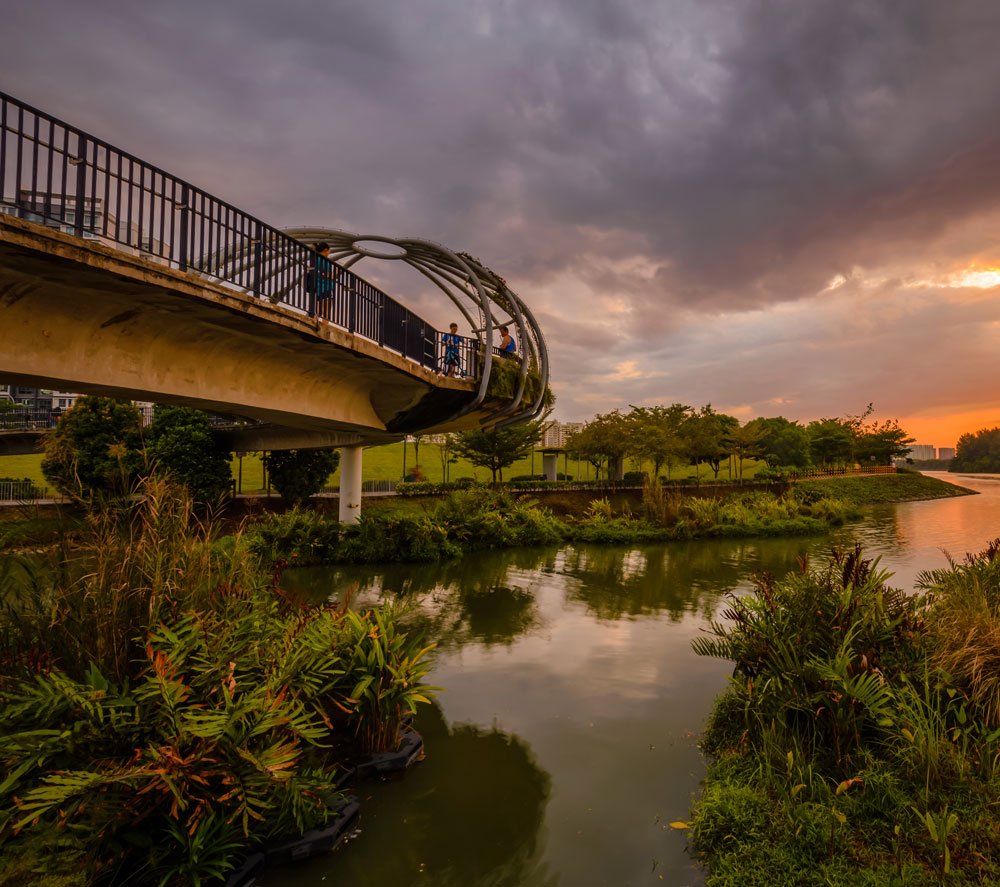
Punggol Waterway provides a rich offering of community spaces
immersed in Nature
The design concept enabled the seamless integration of environmentally sustainable features and storm-water management practices together with the creation of a variety of community spaces.
The Design of Punggol Waterway
The design approach adopted by the team considered four important guiding principles:
- To design the waterway to function as a freshwater reservoir, as a link in the community and as a delightful waterfront environment.
- To preserve the heritage landscape of Punggol.
- To strengthen the site character by introducing water related activities, rearranging existing topography and determining strategic viewpoints.
- To promote sustainability through the design of eco-drains, and use of recycled materials and energy efficient products.
Therefore, the designers saw the waterway as a series of blue (water) and green (water) experiences
for visitors.
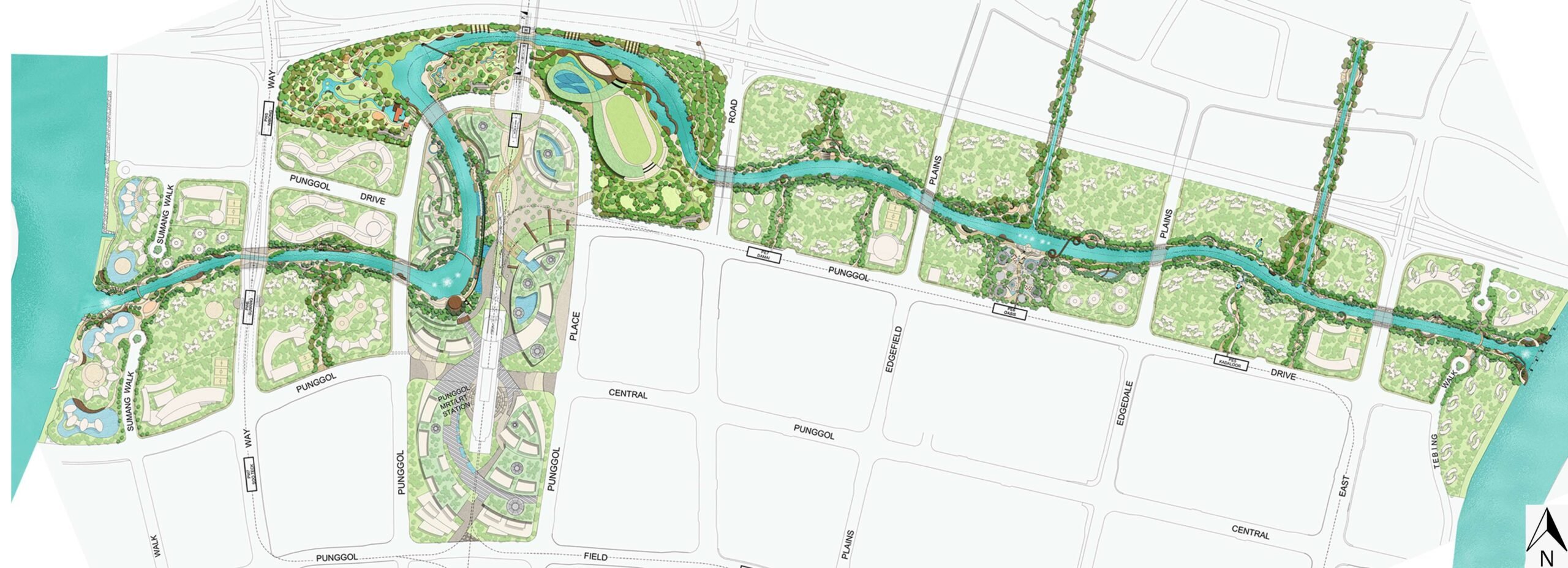
Overall Master Plan
Starting at the east, the waterway boasts a rustic theme in a natural bushland like setting. The
Sunrise Bridge provides a perfect spot to watch the sunrise. The pedestrian ‘kelong’ bridge – with its
traditional stilt-like structure for off-shore platforms that communities used to live in – captures the
mood of old Punggol and leads to the heritage trail with an old bus stop and a 160m stretch of the
original Punggol Road. Punggol Waterway Park, with its lush Green Gallery, inspires artists to create
works of art. Punggol Waterway Park, with a water play area, a sand pit, a fitness corner and
Adventure Bridge, offers a relaxing play area for young families. Across the waterway, a vast open
lawn offers a green community space. The western end offers a more urban experience, where the
“Sunset Bridge” is a popular scenic spot.
The mosaic of activities and facilities along the promenade are best experienced by walking or cycling.
There are five pedestrian bridges, each a distinct landmark, which allow residents to walk or cycle the
entire path uninterrupted. Residents and visitors frequently share photos of their experiences on
Facebook, Instagram and more.
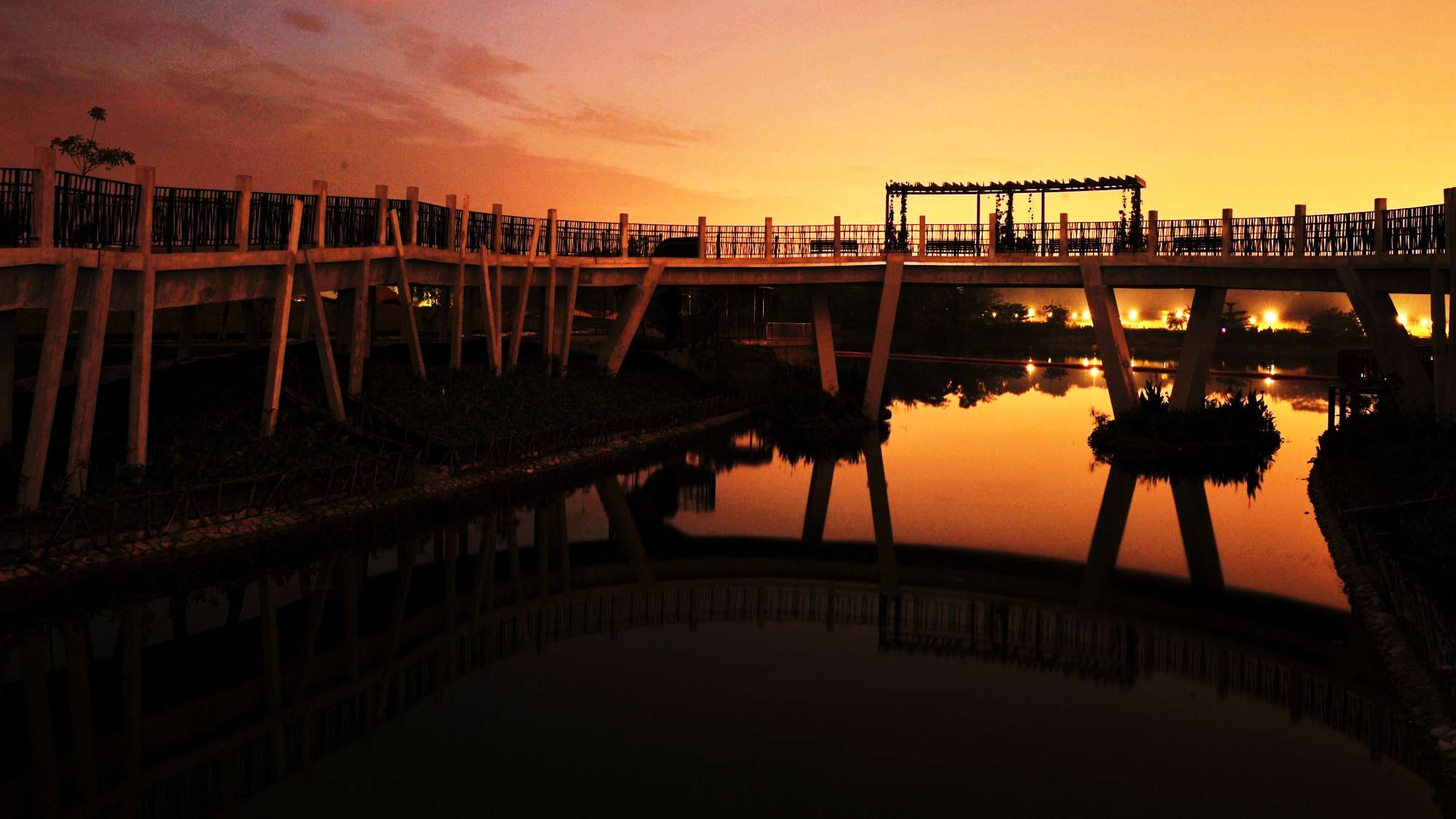
Punggol Waterway’s Rustic Zone
Eco-friendly ABC features
The ABC features are evident along the length of
the promenade. Water entering the waterway is
cleansed using a variety of natural filters.
Eco-drains along both sides of the waterway act as
natural filtration systems to capture and cleanse
surface water run-off before discharging into the
waterway. Floating aerators and jet fountains placed
at regular interval circulate water and improve
oxygen levels, helping to sustain aquatic life. The
aerators are turned on by timers or sensors, when
the dissolved oxygen level of the water falls below a
critical level.
The eastern end of the waterway boasts freshwater
mangroves, which further enhance water quality
through the in-take of nitrates and phosphates,
thereby decreasing the growth of algae in the water.
The sloping east and west riverbanks are planted
with submersible water plants to help cleanse river
water before it enters the waterway.
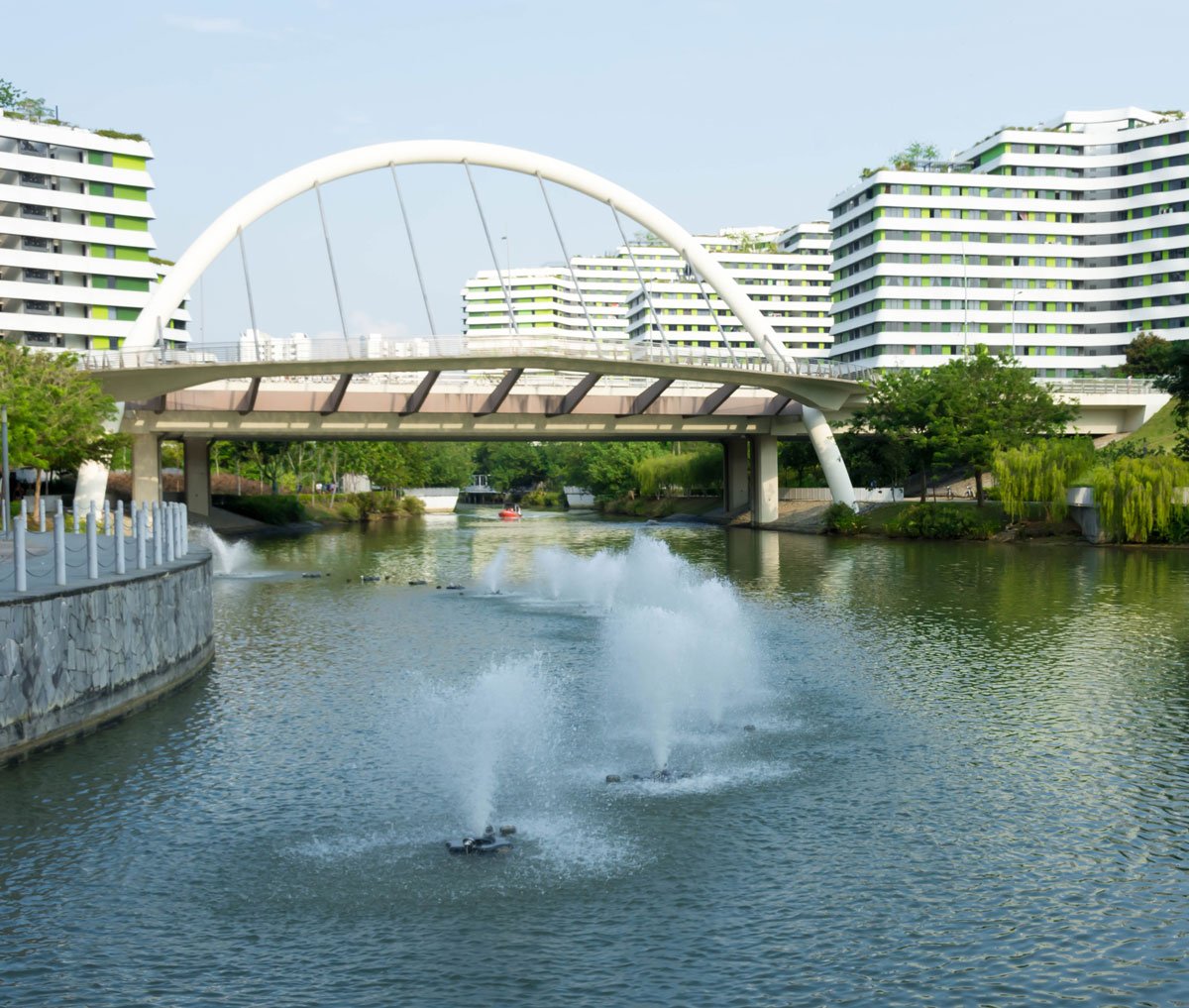
Jet fountains along the waterway augment the natural process of filtering
and cleansing the water
The lush flora and fauna of My Punggol Waterway
Punggol Waterway has realised the vision of eco-friendly waterfront living, demonstrating how the
landscape can be harnessed as a tool in designing for sustainability.
Ten years on, the Punggol Waterway area is home to a wide variety of wildlife species such as birds,
dragonflies and crustaceans. Studies have shown that biodiversity in the area increased by about 20
per cent, helped by the planting species provided including the freshwater-tolerant mangrove. Regular
biodiversity surveys conducted by HDB between 2011 and 2013 recorded numerous species of birds
and insects. Today, it is a popular spot for birdwatchers. The common collared kingfisher, long-tailed
shrike, pink-necked green pigeon, yellow-vented bulbul, rose-ringed parakeet, the white-throated
kingfisher are often sighted here.
The roots of the mangrove trees have helped to naturally stabilise the sloping banks and to act as a filter for the surface run-off. They, together with several other design interventions, help to improve the water quality of the waterway.
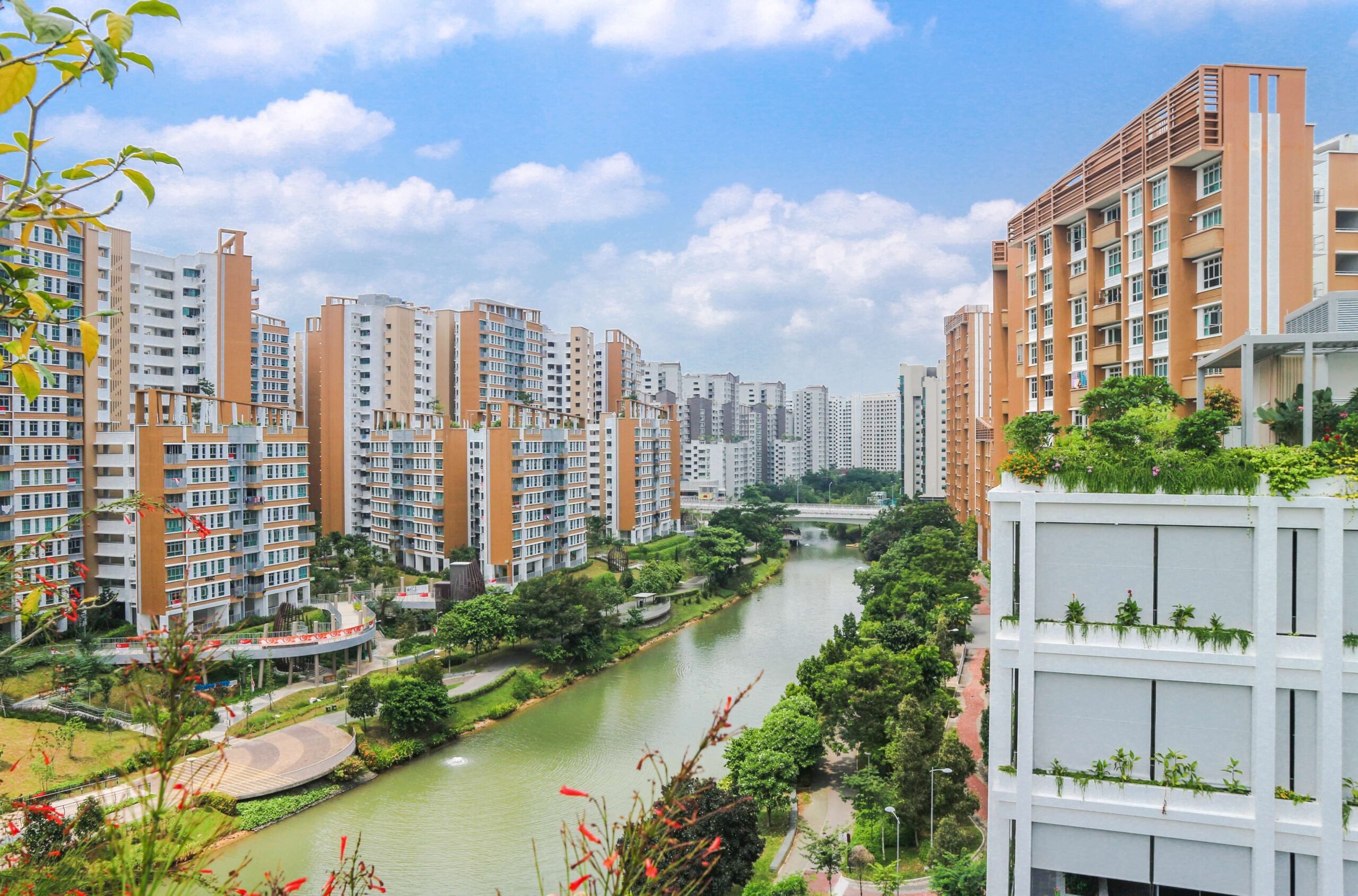
A vibrant HDB estate is flourishing along the Punggol Waterway
Transformed from bare land into a vibrant 4.2-km meandering waterway, Punggol Waterway is an architecture and engineering masterpiece by Surbana Jurong. Today, it is a popular recreational spot, providing a green respite for residents and bird-watching visitors.
Seen as one of the pioneer testing ground for Singapore’s ABC waters programme at a large scale, the
success of Punggol Waterway has led to numerous such projects along many of the nation’s
waterways. The waterway has also shown how innovative solutions to improve water quality has a
positive impact on community-building, leading to similar strategies being deployed in other public
housing estates in Singapore, such as Bidahari and Tampines North.
The project was also widely recognised for its sustainable design and innovative engineering. Surbana
Jurong received many prestigious accolades for the project, such as the International Award for
Liveable Communities (Gold) in 2012, Singapore Gold Design Mark in 2014, and many others.
Project
My Waterway at Punggol
Location
Punggol, Singapore
Size
22.2 ha (4.2 km in length)
Status
Completed in 2011 (2008 – 2011)
Client
Housing Development Board (HDB)
Services
Architectural, Civil & Structural Engineering, Mechanical & Electrical Engineering,
Landscape Architecture, ABC, & Quantity Surveying
Collaboration
PUB, NParks
Firm / BU
SJ Landscape
Project Lead
Oliver Ng
Project Team
Foo Huey Yee, Billie, Suraidi
Keywords
ABC Waters, environmentally sustainable features, storm-water management and
community spaces.
The SEEDS Journal, started by the architectural teams across the Surbana Jurong Group in Feb 2021, is a platform for sharing their perspectives on all things architectural. SEEDS epitomises the desire of the Surbana Jurong Group to Enrich, Engage, Discover and Share ideas among the Group’s architects in 40 countries, covering North Asia, ASEAN, Middle East, Australia and New Zealand, the Pacific region, the United States and Canada.
Articles at a glance






